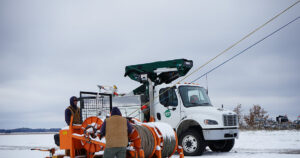Passersby on I-55, which runs right alongside the office of the Association of Illinois Electric Cooperatives on Springfield’s far south side, might catch a glimpse of something new … a shiny, new solar photovoltaic system. The AIEC just installed a pole-mounted, solar PV system that will produce electricity to help power our 20,000 square foot headquarters facility.
The new system consists of 48 solar panels, mounted in a fixed array more than 10 feet off the ground. The panels, which produce electricity in direct current or DC, are wired to two power inverters — installed in an indoor service room — that convert the power to alternating current, or AC power. The system itself is relatively neat and clean, and while high tech, also fairly simple to operate and service.
The PV system is 12.24 kilowatts, or KW, in size. We expect the solar system to produce more than 16,000 kilowatt-hours of electricity annually, or an average of about 1,350 kwh per month. So far, after just the first 18 days of operation, we’ve generated the first 1,000 kwh of electricity. Things appear to operating just as projected — perhaps even a little better than planned.
So, you might ask why the electric cooperatives’ association would install a solar electric system at its office. That’s a logical question, and one we asked ourselves. There are several reasons.
First, we think solar energy has a bright future (no pun intended) and we need to learn more about it. There’s no way better to learn about something than to gain some firsthand experience. That’s probably the most important factor. Second, we have the opportunity to meet some of our own power needs for our facility. So we’ll learn at the same time that we generate power and offset some of our electrical needs and costs. And third, solar installation costs have been coming down and this form of renewable energy is realistic and affordable.
As the statewide organization for all the electric cooperatives, the solar system offers a perfect opportunity for a hands-on learning environment for co-op leaders and employees. When co-op folks come in to our office, as they often do for meetings and training sessions, they’ll be able to monitor the production and performance of the solar system on a lobby television screen. And we’ll all learn more about how the system can endure Illinois weather, and how the generating production might vary from month to month, and season to season.
How much of a “deal” is solar power? Well, solar panel costs have really come down in the past couple years, while technological improvements have made the systems much more efficient and productive. At today’s power costs, we predict that our system will take 18 years for a complete payback of our investment. Just a few years ago, that same system may have taken 30-40 years to pay for itself in energy. All renewable systems have a payback, whether we’re talking about wind power, solar, hydroelectric or geothermal heat pumps. Some are simply longer than others.
Several Illinois cooperatives are also experiencing solar power first hand at their headquarters’ facilities. In Shelbyville, leaders of Shelby Electric Cooperative have installed a major 80 kw solar photovoltaic system on the roofs of several buildings at the co-op headquarters. The system helps to offset the energy needs of operating the co-op headquarters facility. In Winchester, Illinois Rural Electric Cooperative has installed a small, residential-sized system at its headquarters. These systems provide experience and education for co-op leaders and members who want to learn more about solar energy.
We’ll share more information in future issues of ICL. Until then, if you’re just driving by and want to stop by for a closer look at the system, the light’s always on.
John Freitag is the Vice President of Operations for the Association of Illinois Electric Cooperatives and Executive Director of the Geothermal Alliance of Illinois.







